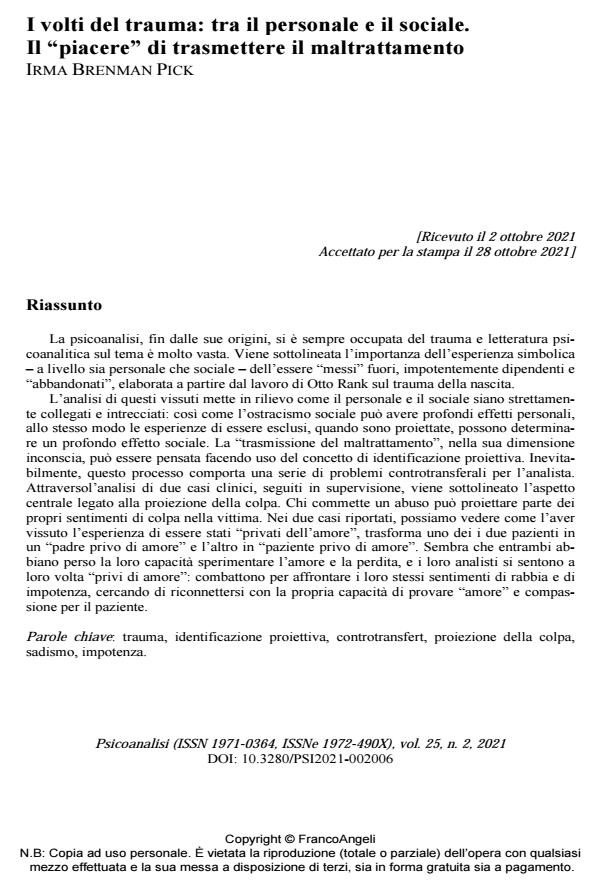The Faces of Trauma: between the Personal and the Social. The "Pleasure" of Passing on the Bad Treatment
Journal title PSICOANALISI
Author/s Irma Brenman Pick
Publishing Year 2021 Issue 2021/2
Language Italian Pages 14 P. 87-100 File size 170 KB
DOI 10.3280/PSI2021-002006
DOI is like a bar code for intellectual property: to have more infomation
click here
Below, you can see the article first page
If you want to buy this article in PDF format, you can do it, following the instructions to buy download credits

FrancoAngeli is member of Publishers International Linking Association, Inc (PILA), a not-for-profit association which run the CrossRef service enabling links to and from online scholarly content.
Psychoanalysis, from its origins, has always dealt with trauma and the psychoanalytic lit-erature on the subject is very wide. The symbolic experience - both on a personal and social level - of being "!put" out, helplessly dependent and "abandoned" is pointed out, starting from Otto Rank’s concept on birth trauma. The analysis of these experiences highlights how the personal and the social are closely linked together: just as social ostracism can have deep personal effects, in the same way the experiences of being excluded, when projected, can determine a deep social effect. The "transmission of the bad treatment", in its unconscious dimension, can be conceived by mak-ing use of the concept of projective identification. Inevitably, this process entails a series of countertransference problems for the analyst. Through the supervision of two clinical cases, the central aspect linked to the projection of guilt is emphasized. Those who commit abuse can project part of their feelings of guilt into the victim. In the two cases reported, we can see how having lived the experience of being "loveless" transforms one of the two patients into a "love-less father" and the other into a "loveless patient" . Both the patients seem to have lost their ability to experience love and loss, and their analysts feel themselves "loveless" too: they fight to face their own feelings of anger and helplessness, trying to reconnect themselves with their own ability to feel "love" and compassion for their patients. .
Keywords: trauma, projective identification, controtransfert, projection of guilt, sadism, help-lessness
Irma Brenman Pick, I volti del trauma: tra il personale e il sociale. Il "piacere" di trasmettere il maltrattamento in "PSICOANALISI" 2/2021, pp 87-100, DOI: 10.3280/PSI2021-002006